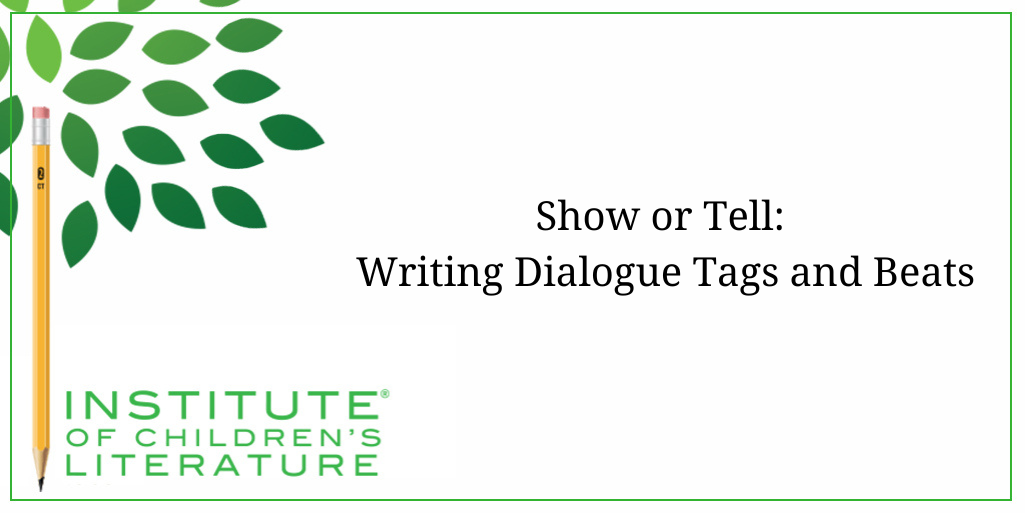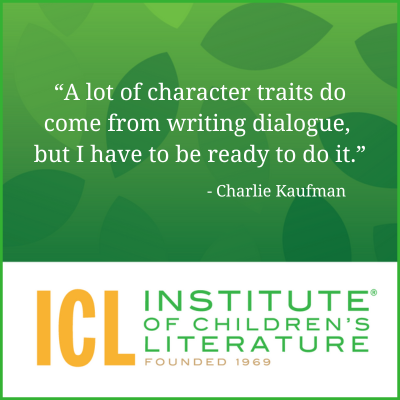
5 Ways Writers Can Prep for 2025 Goal Setting
Before we roll on to the new writing year, let’s harness our optimism for the blank slate before us and prepare for our 2025 Goal Setting just for writers.

Dialogue scenes in fiction are made up of the words spoken by each character and all sorts of things around the spoken words that are intended to keep the reader engaged in the scene and make it easier to understand what is going on.
Writing dialogue can include snippets of inner dialogue as the main character processes what is being said. It can include outside influences like the pouring rain or a stampede of cats running through the scene as the characters speak. It also includes bits that are there to let the reader know which character is saying each portion of speech.

These tiny groups of words are small but mighty. If they aren’t done well, readers are lost and the dialogue is ineffective because readers aren’t focused on it. Let’s give you the tools to be effective when writing dialogue with tags and beats.
The most basic unit of dialogue looks like this:
“We need to go now, before the cats arrive,” Becky said.
In this instance, the words “Becky said” are the speech tag. It’s there specifically to alert the reader to who is speaking. It does nothing else. But often that single important job is enough. Now, there are some small structural variants on this basic unit of dialogue. For instance, you can change where you place the speech tag. You can lead with it:

You can break in the middle of the speech, cutting the words into smaller bits by driving the speech tag right through it:
“We need to go now,” Becky said, “before the cats arrive.”
We can even swap the words of the tag around, though this offers a slightly old-fashioned flavor:
“We need to go now,” said Becky.
With all of the above examples, you’re working with a tag that is nearly invisible. It keeps the reader oriented, but it brings nothing else to the table. Sure, you can dress it up now and then with a different speech word or a bit of adverb, but choices like that shouldn’t be the primary method of adding variety because they tend to give this basic speech tag too much attention, and drag the reader’s attention from the words:
“We need to go now!” Becky screamed.
“We need to go now,” Becky begged.
“We need to go,” Becky whispered urgently, “now.”
Each of these alters the feel of the bit of speech slightly. There are good reasons for choosing any of them. But choosing a speech tag with something other than “[character] said” as the format should be made carefully. Don’t simply pick different speech words or chuck in adverbs because you think you need variety. Do it because the dialogue demands it or don’t do it.
While the speech tag’s job is to orient readers, it doesn’t bring much else to the dialogue party. On the plus side, since “he said” and “she said” are so innocuous, they are nearly invisible. You see them. They do their job. But your brain moves on quickly to focus on the words of the dialogue itself.
Much of the time, that’s exactly what you want. The dialogue reveals the voice of the characters, it shows emotion instead of telling it, it makes us engage with the character, and it moves the plot along. With so much resting on the dialogue, you don’t want the reader focused on the speech tags.
Still, sometimes you do want to bring more to the scene. You want to root the characters in reality. And sometimes you want to reveal emotion in a different way from the words of the dialogue. After all, dialogue sometimes lies. And this is where the action tag or beat shines. This is an example of dialogue tagged with action:

She didn’t believe a word of it.
Now in the above dialogue, we don’t use any speech tag. We don’t say “Vernon said” or “Vernon whispered.” We don’t even use “Vernon prevaricated.” Instead, we see Vernon. We feel his discomfort at the lie he is about to tell. We aren’t relying on the other character to see he is lying; we can see it ourselves.
This kind of use is especially effective because it allows the reader to make a decision (he’s lying) an instant before the character does. And that is emotionally satisfying for a reader. It ticks a little box in our brain that is enjoyable. And it makes us even more engaged with the writing. Vernon isn’t fooling the other character, and he isn’t fooling us. The main character and the reader become a team in that moment. And the reason for that is because we are allowed to see him as he’s speaking. Action tags or beats make that happen.
Action beats work best when there is something the reader should take in beyond the words of the dialogue itself. They shouldn’t simply be tossed in for the sake of adding movement. They need to be thought out so that the action brought into the scene offers more, reveals more, and helps the reader connect more. I’ve occasionally seen writers who get that they need more action in the scene but have no idea how to make it purposeful action, so they write something like this bit of scene, set on a path in the forest:

“You worry too much.” Ned pitched up a rock and pitched it into the trees where it landed with a satisfying plop. “Focus on the plan.”
Joey shoved the ball back in his pocket. “Easy for you to say.” He pulled out a wrapped candy. The paper crinkled as he unwrapped it and shoved it in his mouth. “You aren’t the one who will be grounded into eternity.”
“If we find the treasure,” Ned said, snapping twigs off the fallen tree they passed, “all will be forgiven.” He stopped and pointed. “There it is.”
Joey pulled another candy from his pocket. “We should go home.”
If Ned heard him, he showed no sign. Instead, he picked up his pace to a trot. “Last one there is a mossy lump.”
Joey popped the candy in his mouth. “Being a lump ain’t so bad.”
As you can see, the action does keep us oriented. We aren’t confused about whether it’s Joey or Ned talking, but the action feels random. It isn’t showing us anything. In fact, it feels unlikely, bordering on impossible. Joey is tossing a ball in the air in the woods, which would be difficult unless the path is really wide. And even worse, he pops candy in his mouth and then talks with no suggestion that it affects his speech at all. And Ned is equally involved in aimless motion.
Beats aren’t meant to be aimless. They are meant to deepen character, setting, and mood every bit as much as the dialogue itself is meant to do that. So, beats are great, but they must be purposeful. Which pretty much makes them like every other choice you make as a writer.
There is another thing to be considered in the choice of whether to use a simple speech tag or a beat, and that’s pace. In the above brief scene between Joey and Ned, the pace is slowed by having action throughout. It’s slowed more by the aimlessness of the action because the reader will automatically try to make sense of that, which can be an issue when there is no sense to be made. This can be a serious problem if the scene you’re creating needs to be fast-paced to work.
For example, if you’re writing dialogue for a scene where characters are running full tilt through the woods while chased by someone, adding a ton of lengthy action beats will slow the pace and drain off some of the effectiveness of the scene. You’ll need to keep dialogue short and quick since we don’t usually talk in long wandering sentences when running, but you’re also going to need lots of paragraph breaks and short bursts of action to keep the pace matching what is going on in the scene.
Consider this example:

By way of answer, the door to the cabin burst outwards. Ned thundered out. “Run!”
“What?” Joey managed as Ned caught his arm and dragged him.
“Run!”
“From what?”
Ned didn’t say. He had let go of Joey’s arm and kept running.
That’s when Joey heard groans from inside. And scuffling.
He ran. With his longer legs, he caught up with Ned easily.
Something crashed through the trees behind them. Joey didn’t look. He didn’t dare.
Notice how the dialogue in the above scene is very short. No one has time to talk. We start with long sentences to stretch tension. That helps get the reader ready for the burst that is coming. The reader knows, as Joey does, that somehow this is not going to end well, and is waiting for it. Then when the action event occurs, the sentences shorten. Dialogue comes in single words, commands, or questions. And the pace becomes very fast.
Notice also that we have two pieces of dialogue with no tags at all. When the pace needs to be super-fast and urgent, you may want to drop dialogue tags. That can work only if there is no way for the reader to be confused about who is speaking. We know it is Ned who says, “Run!” because Ned had said it moments before. We know it is Joey posing the question because he is the only one of the two who could possibly be saying it, unless it’s being said by whatever is in the cabin, and that seems unlikely. If we were adding a third character to say “run” or “from what” we would bring in the descriptive backup to keep it clear. Dropping all speech tags or identifying beats can be a viable choice for small bits of a scene, but it must be done carefully without allowing the reader to be confused. When in doubt, tag the speech.
Any time you add something to your writer’s toolkit, you’re taking on a double-edged sword. Handled well and with purpose, you’ve increased your options for making stronger, more engaging writing. Handled poorly you may end up with a confusing scene that loses the interest of the reader through frustration. It’s tricky to keep everything in balance and absolutely no one gets it right all the time. As most of us are avid readers, we’ve all come across moments of confusion or clunky writing, sometimes even in the works of authors we love.
Writing is a complex dance and we all stand the chance of making missteps. But the joy is in the dancing—with variety, with purpose, and with joy. Whether you choose speech tags, beats, or come up with your own new innovation, write with purpose and your reader will reap the rewards.
With over 100 books in publication, Jan Fields writes both chapter books for children and mystery novels for adults. She’s also known for a variety of experiences teaching writing, from one session SCBWI events to lengthier Highlights Foundation workshops to these blog posts for the Institute of Children’s Literature. As a former ICL instructor, Jan enjoys equipping writers for success in whatever way she can.

Before we roll on to the new writing year, let’s harness our optimism for the blank slate before us and prepare for our 2025 Goal Setting just for writers.

Writers can be thin-skinned when it comes to getting feedback on their work. Let’s look at 4 ways to positively deal with constructive criticism!

Rejection is part of the territory when it comes to being a writer. Today we offer reflection for writers to help redirect your efforts after a rejection.
1000 N. West Street #1200, Wilmington, DE 19801
© 2024 Direct Learning Systems, Inc. All rights reserved.

1000 N. West Street #1200, Wilmington, DE 19801
© 2025 Direct Learning Systems, Inc. All rights reserved.

1000 N. West Street #1200, Wilmington, DE 19801
©2025 Direct Learning Systems, Inc. All rights reserved. Privacy Policy.
2 Comments